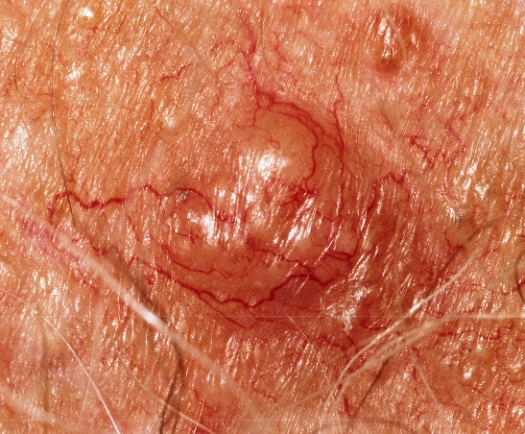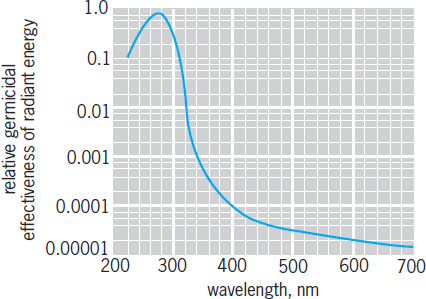Key Concepts
Electromagnetic radiation in the wavelength range of 10 to 400 nanometers that affects biological organisms. The ultraviolet (UV) portion of the electromagnetic spectrum includes all radiations from 10 to 400 nanometers (nm); in addition, radiations as low as 4 nm are sometimes included in this range. Radiations shorter than 200 nm are absorbed by most substances, even by air; therefore, they are technically difficult to use in biological experimentation. Radiations between 200 and 320 nm are selectively absorbed by organic matter, and they produce the best-known effects of ultraviolet radiations in organisms. Radiations between 320 and 400 nm are relatively little absorbed and are less active on organisms. In general, though, ultraviolet radiation in sunlight at the surface of the Earth is restricted to the span from about 290 to 400 nm as a result of the protective effects of the Earth's ozone layer. Notably, and in contrast to x-rays, ultraviolet radiations do not penetrate far into larger organisms; thus, the effects that they produce are surface effects, such as sunburn and development of D vitamins from precursors present in skin or fur. Moreover, excessive exposure to the ultraviolet rays in sunlight can cause skin cancer (Fig. 1). See also: Cancer; Electromagnetic radiation; Radiation biology; Radiation injury (biology); Stratospheric ozone; Ultraviolet radiation; Vitamin D

Photobiological effects
Only the ultraviolet radiations that are absorbed can produce photobiological action. All life activities are shown to be affected by ultraviolet radiations, with the effect depending upon the dosage. Small dosages activate unfertilized eggs of marine animals, reduce the rate of cell division, decrease the synthesis of nucleic acids (especially in the nucleus), reduce the motility of cilia and of contractile vacuoles, and sensitize cells to heat. Large dosages increase the permeability of cells to various substances, inhibit most synthetic processes, produce mutations, stop cell division, decrease the rate of respiration, and may even disrupt cells. The effect of ultraviolet radiations upon cells is invariably deleterious.
Despite their damaging effects, ultraviolet radiations are used as tools in biological research because they stop certain cell activities selectively without introduction of extraneous chemicals. They have been found especially useful in the production of mutations in microorganisms. The mechanism of action upon deoxyribonucleic acid (DNA), present in large amounts in chromosomes, consists primarily of the formation of pyrimidine dimers (chiefly between adjacent thymine residues on a strand), which can interfere with replication of the DNA. See also: Deoxyribonucleic acid (DNA); Mutation
Action spectra
Some wavelengths of ultraviolet radiations are more effective than others. More bacteria are killed by a given dosage of ultraviolet radiation at 260 nm than by the same dosage of radiation at 300 nm. When the bactericidal effectiveness of each of a series of wavelengths is plotted against the wavelength, the resulting curve is an action spectrum for the bactericidal effect (Fig. 2). In addition, action spectra have been determined for many other effects of ultraviolet radiations.

Photoreversal
The action of ultraviolet radiation on cells can be reversed to a considerable degree (although never complete) by simultaneous or subsequent exposure of the irradiated cells to short-wavelength visible (violet and blue) or long-wavelength ultraviolet light. This process has been called photoreversal or photoreactivation. Thus, nucleic acid synthesis, inhibited by ultraviolet radiations, is resumed after exposure to visible light. At the same time, cell division, previously inhibited or retarded, is resumed as well.
Effects on the skin
Erythema is the reddening of the skin following exposure to ultraviolet radiation of wavelength shorter than 320 nm, with a wavelength of 296.7 nm being most effective. These radiations injure cells in the outer layer of the skin, or epidermis, liberating substances that diffuse to the inner layer of the skin, or dermis, causing enlargement of the small blood vessels. A minimal erythemal dose just induces reddening of the skin observed 10 h after exposure. A dose measuring several times the minimal gives a sunburn, killing some cells in the epidermis and causing serum and white blood cells to accumulate, leading to a blister. After the dried blister peels, the epidermis is temporarily thickened and pigment develops in the lower layers of the epidermis, with both of these factors serving to protect against subsequent exposure to ultraviolet radiation.
Both thickening of the epidermis and tanning may occur without blistering. Because the pigment in light-skinned individuals develops chiefly below the sensitive cells in the epidermis, it is not as effective as in dark-skinned individuals, where the pigment is scattered throughout the epidermis. Consequently, the minimal erythemal dose is much higher for dark-skinned individuals than for light-skinned ones.
Most importantly, excessive exposure to ultraviolet radiation is the major factor that causes cutaneous cancer, including melanoma, in humans. See also: Melanoma
Clinical use
Ultraviolet radiations were once used extensively in the treatment of various diseases, including rickets, extrapulmonary tuberculosis [especially skin tuberculosis (lupus vulgaris)], and numerous skin diseases. However, vitamin preparations, synthetic drugs, and antibiotics have either displaced ultraviolet radiations in such therapy or are used in conjunction with the radiations. For example, in conjunction with chemicals, ultraviolet radiations are used in treating a number of skin conditions, including psoriasis, pityriasis rosea, and sometimes acne. Moreover, in individuals who are sensitive to vitamin D preparations, ultraviolet radiations alone are still employed to treat rickets. See also: Skin disorders; Tuberculosis





